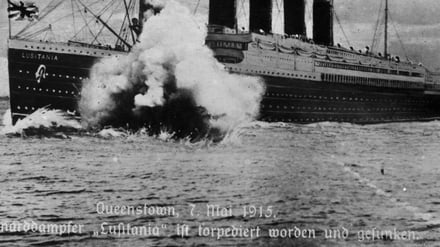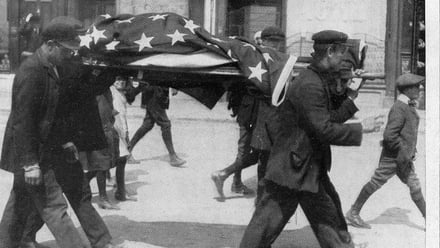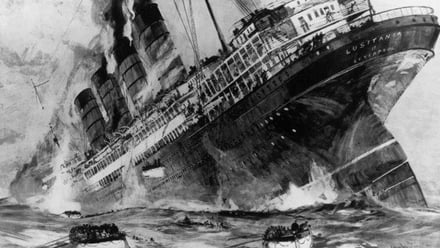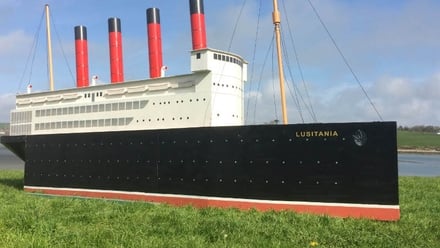Lusitania centenary commemorations commence in Courtmacsherry County Cork this weekend, with a re-enactment on Sunday to remember those who lost their lives on May 7, 1915. Paddy Kehoe talked to Mícheál O’Donovan.
Minister Simon Coveney TD will officially open the centenary weekend tomorrow. Ryder and Courtmacsherry RNLI lifeboats will be on display and visitors can watch a fly-over of the Irish Coast Guard Helicopter.
The main event will be a pageant at Blind Strand in Courtmacsherry on Sunday May 3, at 11.00am. This will be a faithful re-enactment of the RNLI lifeboat's journey out to the site where the Lusitania was hit by the fatal torpedo.
The vessel had already broke many records, being the first ship to cross the Atlantic in under five days. On this occasion, the ship had been travelling from Liverpool to New York when the torpedo was launched by a German U-boat off the coast of Cork. 1,198 passengers and crew lost their lives. There were 761 survivors. What remains of the wreck lies in approximately 300 ft (91 metres) of water.
A number of ships carried the recovered bodies back to Cobh. After the RNLI Lusitania mission was complete, the details were recorded in the Return to Service logbook. They read as follows: “We had no wind, so had to pull the whole distance –on the way to the wreck we met a ship’s boat, cramped with people who informed us the Lusitania had gone down. We did everything in our power to reach the place but it took us three-and-a-half- hours of hard pulling to get there – then only in time to pick up dead bodies.”

Picture shows the torpedoing of the Lusitania as recorded in a German newspaper.
Tim Keohane was coxwain of the Courtmacsherry RNLI lifeboat, Ketzia Gwir, on that fateful day in 1915. His great-grand nephew is 40-year old Mícheál O’Donovan, who will be one of the lifeboat coxwains in the forthcoming re-enactment, along with his brother Brian. The journey out to the location where the Lusitania sank is about 11.2 miles, or 12 nautical miles.
As you might expect, Mícheál never knew his great-grand- uncle Tim Keohane, nor indeed his son, the noted Antarctic explorer, Patrick Keohane. Yet he grew up in a house in the locality known as Coolbawn which was only a stone’s throw from the house where the Keohanes, father and son, once lived.

The body of an American citizen is carried through the streets of Cobh. The sinking of the Lusitania moved public opinion in the United States against Germany and influenced America's eventual declaration of war in 1917.
Curiously, Mícheál began to hear more about Tim when local interest was re-awakened in the life of his son Patrick. Patrick Keohane’s name began to be heard more frequently in recent years as the anniversaries of various Antarctic adventures involving Captain Robert Falcon Scott were commemorated. Indeed Patrick was a member of the search party who found the frozen bodies of Scott, Wilson and Robertson Bowers on November 12, 1912.

Newspaper illustration of the sinking of the Lusitania
“We call him Tim, but back in the day he was known as “Taide,” says Mícheál of the explorer's father, the lifeboat coxwain. “I’ll be honest with you, there never was much said about him up until recently and the 100-year commemoration.”
The unveiling of the bronze statue to Tim’s son he considers to be one of his proudest moments. “Patrick was probably the last of the Arctic explorers to be remembered. Everyone else was remembered in their own right, in their own localities, but he was the very last.” Patrick died in 1950 at the age of 71 in Plymouth.
“But this is even bigger now again now in a sense, " he says about Lusitania100. "I mean my father Paddy was involved in the lifeboat, my two brothers, Brian and Barry, they’re fishermen, they both did about 18, 19 years each but they couldn’t give it as much time because they are fishermen.”
Like his brothers, Mícheál followed the family’s sea-faring tradition. As we speak, he is standing on the deck of the LE Aisling, at Haulbowline. He joined the Irish Navy as a seaman, and subsequently learned his trade as a carpenter/joiner (his official designation is hull artificer). He will soon finish his stint on the LE Aisling and will be able to devote more time to lifeboat duties thereafter.
A lifeboat of the type that was in use in 1915 has been procured for the pageant and re-enactment in Cork. Mícheál was looking forward to a test run with other crew members towards the site of the Lusitania’s demise. However, he doesn’t expect to have to row the full three-and-a-half hours on the day, as there will be a relay system involving local rowing clubs.
“I was trying to take the mick out of some of the organisers there recently. I said, 'what’s all this training about, the rowing and stuff?' They started three months in advance, they organised rowing nights and rowing machines and everything. I said 'do you honestly think that the real lifeboat-men back in the day were out there once a week on rowing machines?'"
"Nobody could answer me,“ he laughs
Courtmacsherry is one of four coastal communities in Co. Cork that are commemorating the Lusitania centenary with a number of events, entitled Lusitania100 Cork, in association with Cork County Council.
For more on Lusitania100 Cork and for a full schedule of events in Cobh, Kinsale, Old Head and Courtmacsherry visit www.visitcorkcounty.com/Lusitania100Cork, @LusitaniaCork on Twitter, or @Lusitania100Cork on Facebook.
Picture shows a 19 foot model of the Lusitania on display at the entrance to Courtmacsherry Village.


